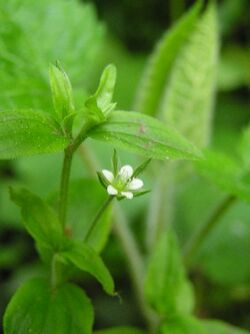Biology:Moehringia trinervia
| Moehringia trinervia | |
|---|---|

| |
| Scientific classification | |
| Kingdom: | Plantae |
| Clade: | Tracheophytes |
| Clade: | Angiosperms |
| Clade: | Eudicots |
| Order: | Caryophyllales |
| Family: | Caryophyllaceae |
| Genus: | Moehringia |
| Species: | M. trinervia
|
| Binomial name | |
| Moehringia trinervia (L.) Clairv.
| |
| Wikimedia Commons has media related to Moehringia trinervia. |
Moehringia trinervia, commonly known as apetalous sandwort[1] or three-nerved sandwort, is a herbaceous flowering plant in the family Caryophyllaceae. A native of Eurasia, it has been introduced into North America.[2]
Description
Three-nerved sandwort is a small, slender, slightly pubescent annual growing 10 – 40 cm tall.[3][4] The leaves are 6 – 25 mm long[5] with three conspicuous longitudinal veins, although some leaves may have up to five veins.[4] The flowers measure approximately 6 mm in diameter, with each bearing ten stamens and three styles. The three-veined sepals are longer than the petals.[6]:485 The flowering period is April until July.[4]
Habitat and distribution
The plant is widely distributed in Britain and much of mainland Europe, although it is absent from the Hebrides, Orkney, and Shetland.[3] It favours fertile, well-drained soils in old lowland deciduous woodland and hedgerows, occurring up to 425 m.[5] In Britain, it is considered an ancient woodland indicator in southern England, East Anglia, and Carmarthen.[3][7] However, three-nerved sandwort may also be found in secondary woodland and can recolonize relatively rapidly after habitat disturbance.[8]
A Polish study in the Niepołomice Forest found that three-nerved sandwort accumulated high amounts of heavy metals from pollutive industrial emissions in its tissues, especially of cadmium. The conclusion was that a high level of heavy metal ions in three-nerved sandwort reflects levels of heavy metal pollutants in the soil and atmosphere, so that this plant may serve as a useful bioindicator of environmental pollution with such metals.[9]
Similar species
Three nerved sandwort superficially resembles chickweed but is distinguished from the latter by its deep longitudinal leaf veins and undivided petals. .
References
- ↑ "Moehringia trinervia". Natural Resources Conservation Service PLANTS Database. USDA. https://plants.usda.gov/core/profile?symbol=MOTR2. Retrieved 13 July 2015.
- ↑ Rabeler, Richard K.; Hartman, Ronald L.. "Moehringia trinervia". in Flora of North America Editorial Committee. Flora of North America (online). eFloras.org. http://www.efloras.org/florataxon.aspx?flora_id=1&taxon_id=242000579. Retrieved 2015-07-18.
- ↑ 3.0 3.1 3.2 Rose F. 2006. The Wildflower Key. Warne.
- ↑ 4.0 4.1 4.2 Gibbons B, Brough P. 2008. Guide to Wildflowers of Britain and Northern Europe. Philips
- ↑ 5.0 5.1 Streeter D, Hart-Davis C, Hardcastle A, Cole F, Harper L. 2009. Collins Wildflower Guide. HarperCollins.
- ↑ Stace, C. A. (2019). New Flora of the British Isles (Fourth ed.). Middlewood Green, Suffolk, U.K.: C & M Floristics. ISBN 978-1-5272-2630-2.
- ↑ Rose F. 1999. Indicators of ancient woodland: the use of vascular plants in evaluating ancient woodlands for nature conservation. British Wildlife 10: 241 – 251.
- ↑ Ray DB, Hill MO, Rothery P. 1999. Effects of urban land cover on the local species pool in Britain. Ecography 22: 507 – 515.
- ↑ Godzik B. 1992. Moehringia trinervia (L.) Clairv. – a bioindicator of heavy metal pollution in the environment. Acta Societatis Botanicorum Poloniae 61 (3-4): 409 – 417.
Wikidata ☰ Q159024 entry
 |

